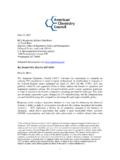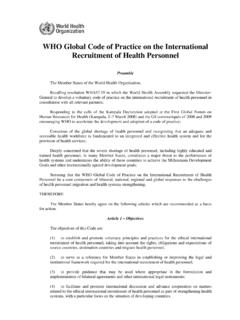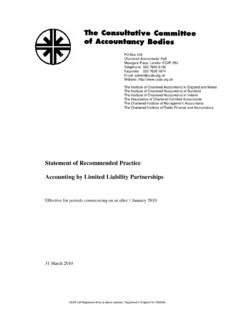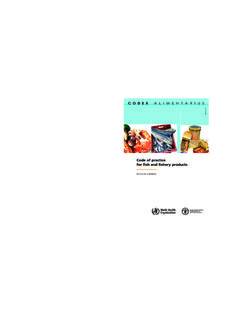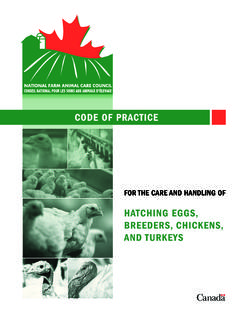Transcription of Petroleum Additives Product Approval Code of Practice
1 AMERICAN CHEMISTRY COUNCIL Petroleum Additives Product Approval code OF Practice January 2018 Copyright 2018 by the American Chemistry Council Copyright Notice American Chemistry Council (2018) This work is protected by copyright. The American Chemistry Council (formerly CMA), which is the owner of the copyright, hereby grants a nonexclusive royalty-free license to reproduce and distribute this code of Practice , subject to the following limitations: 1. The code must be reproduced in its entirety, without alterations. 2. All copies of the code must include a cover page bearing American Chemistry Council s notice of copyright and this notice. 3. Copies of the code may not be sold. January 2018 American Chemistry Council code of Practice American Chemistry Council Petroleum Additives Product Approval code of Practice Table of Contents Page code of Practice 1-3 Appendix A - Requirements for Engine Test Stand/Laboratory Calibration A1-Addendum A1 Appendix B - Candidate Scheduling.
2 Registration and Tracking Procedure B1-B9 Appendix C - American Chemistry Council Monitoring Agency C1-C2 Appendix D - Engine Test Stand Selection D1-D5 Appendix E - Candidate Data Package E1-E7 Appendix F - Multiple Test Evaluation Procedures F1-F8 Appendix G - Engine Test Operational Validity Criteria G1-G4 Appendix H - Guidelines for Minor Formulation Modifications H1-H11 Appendix I - Program Guidelines I1-I2 Appendix J - Compliance J1-J22 Appendix K - Template for Acceptance of New Tests K1-Addendum K6 Tab 1 - Glossary of Terms 1-4 Tab 2 - American Chemistry Council code Bulletins 1 Tab 3 - American Chemistry Council Monitoring Agency code Bulletins 1 Tab 4 - American Chemistry Council code Interpretations 1-24 Tab 5 - Procedural Interpretation 1-4 January 2018 American Chemistry Council code of Practice Page 1 American Chemistry Council Petroleum Additives Product Approval code of Practice1 Purpose This code of Practice will help ensure that a particular engine lubricant meets its performance specifications.
3 This will be accomplished through the use of specified engine tests, procedures, and record-keeping. Implementation of this code in engine testing will provide more accurate performance results, thereby yielding more cost-effective engine testing - a mutual benefit both to lubricant formulators and their customers. In addition, communications between sponsors and customers will be improved because standard practices are described in detail. This code represents the best efforts of the American Chemistry Council (ACC) Petroleum Additives Panel to develop a code of Practice for Product Approval . It is intended that adherence to this code will result in continuous improvement in accuracy and precision of all engine tests covered by the code . The code will be updated on an ongoing basis. Compliance with the code is voluntary and is not restricted to ACC member companies.
4 For a company to achieve and maintain compliance, that company must conduct all candidate oil engine tests and programs on a worldwide basis in accordance with practices specified by the code , for tests listed within the code (see Appendix A). Definition of Terms Key terms are defined in the Glossary, which should be consulted for assistance in interpreting provisions of this code . practices 1. All engine testing for Product Approval must be conducted using only equipment and facilities in compliance with monitoring and calibration requirements of the ASTM Test Monitoring Center (TMC) and meeting the requirements for engine test stand/laboratory calibration in Appendix A. 2. Testing of a candidate in a particular test type can only commence following proper scheduling and registration (see Appendix B) of that test with the ACC Monitoring Agency (see Appendix C).
5 3. Test laboratory is at the choice of the sponsor. However, no pre-selection of test 1 This code of Practice was not developed as a code under the American Chemistry Council RESPONSIBLE CARE initiative, and is separate and distinct from that initiative. January 2018 American Chemistry Council code of Practice Page 2 stands is allowed and all calibrated test stands within a laboratory, meeting Appendix A requirements, are to be made available for all candidate submissions. Test stand assignment is as defined in Appendix D. 4. Final test results of a candidate will utilize current - time test severity adjustments ( ) in accordance with Appendix A. Severity adjustments are to be included in the test report. 5. The test laboratory will supply the results of all tests initiated by registration simultaneously: i) to the ACC Monitoring Agency for inclusion in the data base, and ii) to the sponsor for inclusion in the Candidate Data Package as specified in Appendix E.
6 All test results must be supplied for any program run under the code . The data will be entered into the ACC Monitoring Agency data base. 6. All chemical & physical tests are to be conducted in laboratories current in participation in the ASTM Interlaboratory Crosscheck Program for the particular tests. 7. Conformance to passing limits in a specific engine test will be determined using Multiple Test Evaluation Procedures (MTEP) in Appendix F. Only engine tests meeting ASTM test guidelines and ACC guidelines for operational validity in Appendix G are to be considered. All valid tests are to be considered for MTEP, except as specified in Appendix E. 8. If questions arise as to the validity of a specific test or test result, the test laboratory or test sponsor may seek an opinion and/or industry test severity and precision information from the ACC Monitoring Agency (see Appendix E).
7 Such opinions and/or information shall be included in the Candidate Data Package. 9. Minor formulation modifications are permissible during development of the Core Data Set (see Appendix H). All such modifications and support data will be disclosed to the customer and included in the Candidate Data Package. 10. Programs will be conducted in accord with Program Guidelines (see Appendix I). These guidelines and those for minor formulation modifications may be combined with applicable API guidelines within API Publication 1509. Use of the Program Guidelines will be disclosed to the customer and support data will be included in the Candidate Data Package. 11. Compliance with the code will be determined by annual review by an independent auditor (see Appendix J). A Self-Evaluation Checklist prepared by the company and endorsed by the auditor will be submitted to ACC annually as part of complying with the code .
8 12. A decision to accept tests into the code will be made following joint efforts by the test developer, the ACC Technical Advisory Group and any third parties, as appropriate, which target bringing the test into compliance with the Template for Acceptance of New Tests (see Appendix K). If the engine test is to be used as part of a category, a demonstration oil is necessary to establish the performance limits of the tests comprising the category. Such an oil must meet the performance limits of each of the tests within the category. January 2018 American Chemistry Council code of Practice Page 3 Process Evaluation Implementation of the code is a quality process. Evaluation of implementation of the code will proceed via annual review. As indicated in the Purpose, the code will be updated on an ongoing basis.
9 Recommended enhancements should be forwarded to the Manager, Petroleum Additives Product Approval Protocol Task Group (PAPTG), American Chemistry Council, 700 Second Street, NE, Washington, DC 20002. January 2018 American Chemistry Council code of Practice AMERICAN CHEMISTRY COUNCIL Product Approval code OF Practice APPENDIX A Requirements for Engine Test Stand/Laboratory Calibration January 2018 American Chemistry Council code of Practice Page A-1 APPENDIX A REQUIREMENTS FOR ENGINE TEST STAND/ LABORATORY CALIBRATION Introduction The engine test stand/laboratory calibration requirements, which are monitored and benchmarked by American Chemistry Council (ACC), consist of state-of-the-art calibration methodologies to manage test precision and severity. The ACC requirements are supplementary to ASTM Test Monitoring Center (TMC) test stand and test laboratory requirements, , TMC calibration is a prerequisite for code Practice .
10 Purpose This Appendix provides the minimum calibration requirements for engine test stands and laboratories that must be met in order for candidate testing to commence under the code . Discussion Details on the calibration requirements are provided in the ASTM Lubricant Test Monitoring System (LTMS) Manual defined in ASTM Test Monitoring Center Technical Memorandum 94-200. This manual must be adhered to for the purposes of ACC calibration. The manual may be obtained from the ASTM TMC at the following address: ASTM Test Monitoring Center, 6555 Penn Avenue, Pittsburgh, PA 15206-4489 (phone) 412/365-1000, (fax) 412/365-1047 When the use of the LTMS is called for, there is a potential need for the application of engineering judgment. The process for acceptance of such engineering judgment is included as Addendum A1, in this Appendix.

